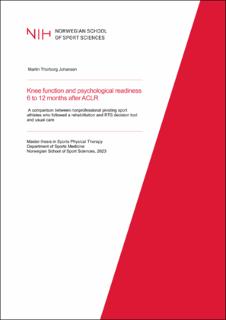| dc.description.abstract | Background: The better and safer return to sports (BEAST) - a rehabilitation and return to sports (RTS) decision tool has been designed to facilitate athletes returning safely to sports after anterior cruciate ligament reconstruction (ACLR). There is a need to investigate and compare knee function and psychological readiness during the return to sport phase in athletes following the BEAST tool and usual care.
Objective: To compare change in knee function and psychological readiness to RTS 6 to 12 months after ACLR between nonprofessional pivoting sport athletes who followed the BEAST tool versus usual care.
Design: A comparison between two prospective cohort studies
Method: Nonprofessional pivoting sport athletes aged 15-40 years with a primary unilateral ACLR were included. Out of 247 athletes, 77 followed the BEAST tool, and 170 received usual care (SPARX cohort). The International Knee Documentation Committee subjective knee form (IKDC-SKF) and ACL- Return to Sport after Injury (RSI) was answered electronically 6 and 12 months postoperative. The 6 to 12 months change between the groups was analyzed, adjusted for age, sex, preinjury sport, family history of ACL injury, time from injury to surgery, ACL graft type, concomitant meniscus and/or cartilage injury yes/no, and meniscal repair yes/no.
Results: No difference in change in knee function (p=0.722) or psychological readiness (p=0.518) was found between the groups. At 6 and 12 months postoperative, the IKDC-SKF scores in BEAST athletes increased from 72.3 to 85.3, and usual care from 67.3 to 79.9. The ACL-RSI scores in BEAST athletes increased from 60.3 to 71.6, and usual care from 48.4 to 56.3. At 12 months postoperative, 48% and 35% of the BEAST athletes had not achieved symmetrical quadriceps strength and hop performance, respectively.
Conclusion: Nonprofessional pivoting sport athletes with ACLR who followed the BEAST tool have comparable 6 to 12 months change in knee function and psychological readiness to RTS when compared to usual care. Few athletes following the BEAST tool achieved the functional goals within 12 months postoperative. | en_US |
